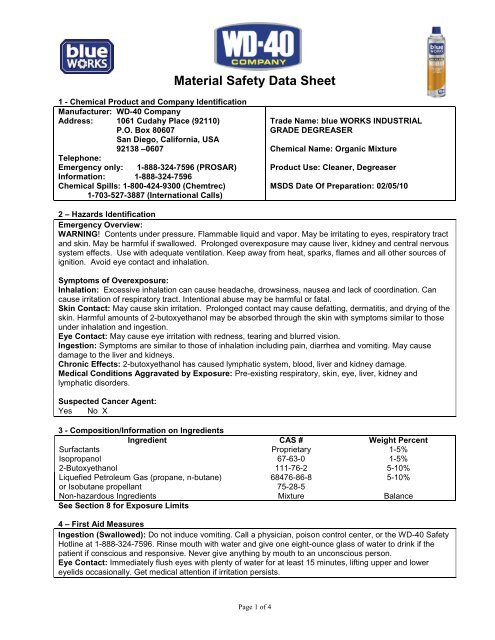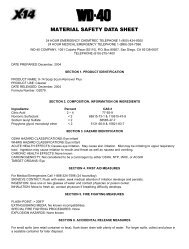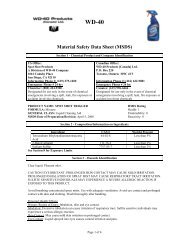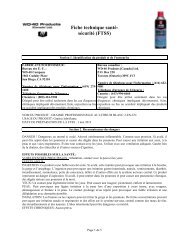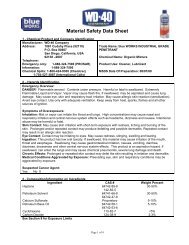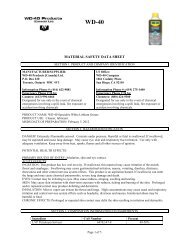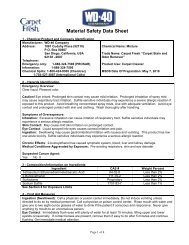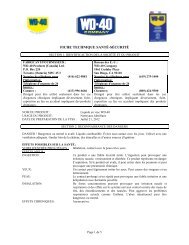Material Safety Data Sheet (MSDS) - WD-40 Company
Material Safety Data Sheet (MSDS) - WD-40 Company
Material Safety Data Sheet (MSDS) - WD-40 Company
You also want an ePaper? Increase the reach of your titles
YUMPU automatically turns print PDFs into web optimized ePapers that Google loves.
<strong>Material</strong> <strong>Safety</strong> <strong>Data</strong> <strong>Sheet</strong>1 - Chemical Product and <strong>Company</strong> IdentificationManufacturer: <strong>WD</strong>-<strong>40</strong> <strong>Company</strong>Address: 1061 Cudahy Place (92110)P.O. Box 80607San Diego, California, USA92138 –0607Telephone:Emergency only: 1-888-324-7596 (PROSAR)Information: 1-888-324-7596Chemical Spills: 1-800-424-9300 (Chemtrec)1-703-527-3887 (International Calls)Trade Name: blue WORKS INDUSTRIALGRADE DEGREASERChemical Name: Organic MixtureProduct Use: Cleaner, Degreaser<strong>MSDS</strong> Date Of Preparation: 02/05/102 – Hazards IdentificationEmergency Overview:WARNING! Contents under pressure. Flammable liquid and vapor. May be irritating to eyes, respiratory tractand skin. May be harmful if swallowed. Prolonged overexposure may cause liver, kidney and central nervoussystem effects. Use with adequate ventilation. Keep away from heat, sparks, flames and all other sources ofignition. Avoid eye contact and inhalation.Symptoms of Overexposure:Inhalation: Excessive inhalation can cause headache, drowsiness, nausea and lack of coordination. Cancause irritation of respiratory tract. Intentional abuse may be harmful or fatal.Skin Contact: May cause skin irritation. Prolonged contact may cause defatting, dermatitis, and drying of theskin. Harmful amounts of 2-butoxyethanol may be absorbed through the skin with symptoms similar to thoseunder inhalation and ingestion.Eye Contact: May cause eye irritation with redness, tearing and blurred vision.Ingestion: Symptoms are similar to those of inhalation including pain, diarrhea and vomiting. May causedamage to the liver and kidneys.Chronic Effects: 2-butoxyethanol has caused lymphatic system, blood, liver and kidney damage.Medical Conditions Aggravated by Exposure: Pre-existing respiratory, skin, eye, liver, kidney andlymphatic disorders.Suspected Cancer Agent:Yes No X3 - Composition/Information on IngredientsIngredient CAS # Weight PercentSurfactants Proprietary 1-5%Isopropanol 67-63-0 1-5%2-Butoxyethanol 111-76-2 5-10%Liquefied Petroleum Gas (propane, n-butane)68476-86-85-10%or Isobutane propellant75-28-5Non-hazardous Ingredients Mixture BalanceSee Section 8 for Exposure Limits4 – First Aid MeasuresIngestion (Swallowed): Do not induce vomiting. Call a physician, poison control center, or the <strong>WD</strong>-<strong>40</strong> <strong>Safety</strong>Hotline at 1-888-324-7596. Rinse mouth with water and give one eight-ounce glass of water to drink if thepatient if conscious and responsive. Never give anything by mouth to an unconscious person.Eye Contact: Immediately flush eyes with plenty of water for at least 15 minutes, lifting upper and lowereyelids occasionally. Get medical attention if irritation persists.Page 1 of 4
Skin Contact: Rinse skin with water for 15 minutes. Remove contaminated clothing and wash before reuse.Get medical attention if irritation persists or symptoms of exposure develop.Inhalation (Breathing): Remove to fresh air. If not breathing, give artificial respiration. If breathing is difficult,give oxygen. Get medical attention if irritation or symptoms persist.5 – Fire Fighting MeasuresExtinguishing Media: Use water fog, dry chemical, carbon dioxide or foam.Special Fire Fighting Procedures: Firefighters should always wear positive pressure self-containedbreathing apparatus and full protective clothing. Cool fire-exposed containers with water. Use shielding toprotect from bursting cans.Unusual Fire and Explosion Hazards: Contents under pressure. Keep away from ignition sources andopen flames. Exposure of containers to extreme heat and flames can cause them to rupture often with violentforce. Concentrate is a flammable liquid. Vapors are heavier than air and may travel to remote ignitionsources and flash back. A vapor and air mixture can create an explosion hazard in confined spaces.6 – Accidental Release MeasuresRemove personnel from general area. Wear appropriate protective clothing (see Section 8). Ventilate thearea and eliminate all sources of heat. Contain and collect liquid with an inert absorbent and place in acontainer for disposal. Clean spill area thoroughly. Report spills to authorities as required.7 – Handling and StorageHandling: Avoid contact with eyes. Avoid prolonged contact with skin. Avoid breathing vapors or aerosols.Use with adequate ventilation. Keep away from heat, sparks, pilot lights, hot surfaces and open flames.Unplug electrical tools, motors and appliances before spraying or bringing the can near any source ofelectricity. Electricity can burn a hole in the can and cause contents to burst into flames. To avoid seriousburn injury, do not let the can touch battery terminals, electrical connections on motors or appliances or anyother source of electricity. Wash thoroughly with soap and water after handling. Keep containers closed whennot in use. Keep out of the reach of children. Do not puncture, crush or incinerate containers, even whenempty.Storage: Store in a cool, well-ventilated area, away from incompatible materials and heat, sparks or openflame. Do not store in direct sunlight or above 120°F. U.F.C (NFPA 30B) Level 1 Aerosol.8 – Exposure Controls/Personal ProtectionChemicalOccupational Exposure LimitsSurfactantsIsopropanol2-ButoxyethanolPropanen-ButaneIsobutaneNon-hazardous IngredientsNone Established200 ppm TWA, <strong>40</strong>0 ppm STEL ACGIH-TLV<strong>40</strong>0 ppm TWA OSHA PEL20 ppm TWA ACGIH TLV50 ppm TWA (Skin) OSHA PEL1000 ppm TWA ACGIH TLV1000 ppm TWA OSHA PEL1000 ppm TWA ACGIH TLV1000 ppm TWA ACGIH TLVNone EstablishedThe Following Controls are Recommended for Normal Consumer Use of this ProductEngineering Controls: Use in a well-ventilated area.Personal Protection:Eye Protection: Avoid eye contact. Always spray product away from your face.Skin Protection: Avoid prolonged or repeated skin contact. Chemical resistant gloves recommended foroperations where skin contact is likely.Respiratory Protection: None needed for normal use with adequate ventilation.Page 2 of 4
For Bulk Processing or Workplace Use the Following Controls are RecommendedEngineering Controls: Use adequate general and local exhaust ventilation to maintain exposure levelsbelow that occupational exposure limits.Personal Protection:Eye Protection: <strong>Safety</strong> goggles recommended where eye contact is possible.Skin Protection: Wear chemical resistant gloves.Respiratory Protection: None required if ventilation is adequate. If the occupational exposure limits areexceeded, wear a NIOSH approved respirator. Respirator selection and use should be based on contaminanttype, form and concentration. Follow OSHA 1910.134, ANSI Z88.2 and good Industrial Hygiene practice.Work/Hygiene Practices: Wash with soap and water after handling.9 – Physical and Chemical PropertiesBoiling Point: 212°F (100° C)(concentrate) Specific Gravity: 1.0 kg/l (concentrate)0.955 kg/L (with propellant)Solubility in Water: Complete pH: 10.5-11.5Vapor Pressure: Not Determined Vapor Density: Not DeterminedPercent Volatile: >95% VOC: 17.3% (162.2 g/L)Coefficient of Water/ Not DeterminedAppearance/ Clear colorless liquid with aOil Distribution:Flash Point:212°F (100°C) (concentrate only)Odor:FlammableLimits:citrus odor.LEL: 1.8% UEL: 9.5%(propellant)10 – Stability and ReactivityStability: StableHazardous Polymerization: Will not occur.Conditions to Avoid: Extreme heat, sources of ignition, physical damage to aerosol can.Incompatibilities: Strong oxidizers.Hazardous Decomposition Products: Thermal decomposition may yield carbon monoxide, carbon dioxide.11 – Toxicological InformationSurfactant: Oral rat LD50: 412-2394 mg/kg, Dermal rabbit LD50 1127-2395 mg/kg, Inhalation rat LC50 1.06mg/L/4 hrIsopropanol: Inhalation rat LC50 16,000 ppm/8 hr, Oral rat LD50 5045 mg/kg, Dermal rabbit LD50 12,800mg/kg2-Butoxyethanol: Inhalation rat LC50 450 ppm/4 hr; Oral rat LD50: 1,480 mg/kg; Dermal rabbit LD50: 490mg/kgLiquefied Petroleum Gas: No toxicity data is availableIsobutane: Inhalation rat LC50 570000 ppm/15 min.None of the components of this product is listed as a carcinogen or suspected carcinogen or is considered areproductive hazard.12 – Ecological InformationNo data is currently available.13 - Disposal ConsiderationsAerosol containers should not be punctured, compacted in home trash compactors or incinerated. Emptycontainers may be disposed of through normal waste management options. Dispose of all waste product,absorbents, and other materials in accordance with applicable Federal, state and local regulations.Page 3 of 4
14 – Transportation Information_DOT Surface Shipping Description: Consumer Commodity, ORM-DIMDG Shipping Description: UN1950, Aerosols, 2.1, LTD QTY15 – Regulatory InformationU.S. Federal Regulations:CERCLA 103 Reportable Quantity: This product is not subject to CERCLA reporting requirements,however, many states have more stringent release reporting requirements. Report spills required underfederal, state and local regulations.SARA TITLE III:Hazard Category For Section 311/312: Acute Health, Chronic Health, Fire Hazard, Sudden Release ofPressureSection 313 Toxic Chemicals: This product contains the following chemicals subject to SARA Title IIISection 313 Reporting requirements: 2-butoxyethanol 5-10% (glycol ether compound)Section 302 Extremely Hazardous Substances (TPQ): NoneEPA Toxic Substances Control Act (TSCA) Status: All of the components of this product are listed on theTSCA inventoryCanadian Environmental Protection Act: All of the ingredients are listed on the Canadian DomesticSubstances List or exempt from notificationCanadian WHMIS Classification: Class A (Compressed Gas), Class B-2 (Flammable Liquid), Class D-2-B(A toxic material causing other harmful effects)This <strong>MSDS</strong> has been prepared according to the criteria of the Controlled Products Regulation (CPR) and the<strong>MSDS</strong> contains all of the information required by the CPR.16 – Other Information:HMIS Hazard Rating:Health – 1 (slight hazard), Fire Hazard – 2 (moderate hazard), Physical Hazard – 0 (minimal hazard)SIGNATURE:TITLE: Director of Global Quality AssuranceREVISION DATE: February 2010 SUPERSEDES: November 2009Page 4 of 4


